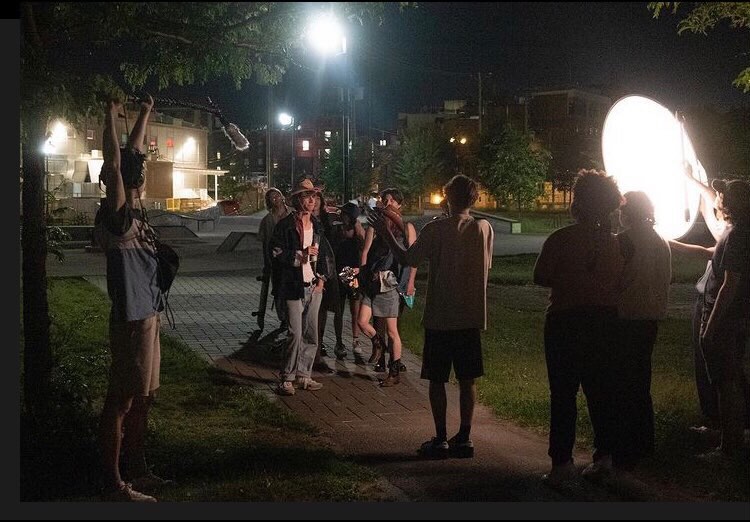Finding alternative means of fundings in the cinema industry crucial more than ever before
As new cohorts of young creatives, freshly graduated from CEGEPs and universities are developing their own audiovisual works, the world of independent cinema is undergoing a revolution, both creatively and technologically.
New faces are entering the business with the modernized technologies and social networks that have revolutionized the distribution and communication around films and series. One of the challenges that awaits these young people in the film industry, however, is the question of funding.
When Catherine Quesnel read the script for what was supposed to be a short film sent to her by her friend and classmate Eléonore Delvaux-Beaudoin, she decided to co-direct it with her in the form of a mini web series. One of the obstacles she quickly discovered was the issue of production.
While the inspiration to write and create was not lacking for these two CEGEP students, the question quickly arose as to how they would finance their project.
The duo asked for help from their classmates Lu Sergei Denaud and Léa Desjardins, who became producers on the project. Soon, they were joined by other fellow students to create a production team for the web series Léo au féminin.
They explained that the first thing that was on their mind when starting was to clearly define how they were going to merge the artistic side with the production side.
“It was always about constantly defining, ‘How many people do we need? What are all the steps? This takes money, how do we find it?’ ” explained Desjardins. “There is no set rule to follow, you have to constantly be looking, searching for the information.”
The team already had some technical notions of organization and production that they had learned in school during their film classes.
“We tried to give ourselves a good structure, an organization as soon as we started the pre-production and then we had to ask ourselves the question of how to find funding in Quebec,” said Denaud.
The team first looked at funding opportunities throughout Quebec’s state-funded organizations for the development of arts and culture, such as the Conseil des arts et des lettres du Québec and the Société de développement des entreprises culturelles (SODEC).
“At the beginning we thought we would go for subsidies, but it was not easy,” said Desjardins. SODEC does offer a funding program for people starting out in the industry.
However, it proved to be too complicated for the young team to apply for financial aid: “It’s very complicated: you must fill out a lot of documents, you must know which team you have, and you must have UDA members for the actors,” explained Desjardins.
L’Union des artistes (UDA) is a professional union tasked with representing artists who speak French, or any language other than English within Canada.
However, the team had decided to hire people from their network of young actors and directors to work on the series. None of them had a foot in the door yet and were by no means already unionized. The team’s inexperience was therefore the defining factor that did not make them eligible for the grant.
The production team decided to register the series as an “amateur” not-for-profit production and not a “professional” one, which wouldn’t allow them to ask for subsidies but would give them more freedom.
“We decided to be amateur officially, but as professional as possible in practice. We wanted to give it all anyway,” said Desjardins. Denaud also added that this gave them more freedom on shooting, and release dates.
This freedom, they discovered, was also obtained from the rejections they had received from numerous production companies. This allowed them to stay independent and make the series the way they wanted, without any obligations from a company.
Nonetheless, from these rejections came the precious help of a producer who decided to be their mentor. They also found the help of a professional film editor who was willing to edit the series voluntarily.
Jonathan Beaulieu-Cyr, a young independent producer and director from Montreal, explained that it is complicated to find funding for a project as a fresh graduate starting out in the industry.
“Organizations such as SODEC and Telefilms give generous amounts of money, but you must be very advanced in your career,” said Beaulieu-Cyr. “I know that I am very lucky personally to be able to make a living exclusively from film, it is very rare.”
Wiebke von Carolsfeld, a film director, writer, editor, and a teacher at Concordia’s Mel Hoppenheim School of Cinema agreed with Beaulieu-Cyr.
“You have to pay up before you get paid and that can drag on forever,” she said. “It does put an interesting dilemma in the beginning, for example, how are you going to get experience to get hired?”
Von Carolsfeld added that she believes that the most important thing for young creatives is mentorship and access to professionals in the field who are willing to offer their help to navigate the complicated industry.
This is exactly what allowed the team of Léo au féminin to produce the series. Quesnel explained how creating connections worked to their advantage.
“For example, we had a friend who was going to be one of our actors who had friends who did lighting,” said Quesnel. “And those people rented a studio so connecting with them allowed us to have some kind of headquarters and people that were good with lighting and good with equipment.”
Through a call for donations on GoFundMe, the team managed to raise funds, gather a social media following in the process and develop a solid network of friends, classmates, and people in the industry that finally led to the success of their project.
